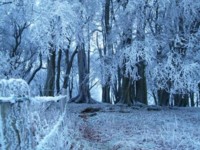How fast can our climate change - very fast apparently
 It took only a few months for Europe to be engulfed by an ice age according to the most precise record of the climate from palaeohistory ever generated. The scenario, which comes straight out of Hollywood blockbuster The Day After Tomorrow, was revealed by researchers at the University of Saskatchewan.
It took only a few months for Europe to be engulfed by an ice age according to the most precise record of the climate from palaeohistory ever generated. The scenario, which comes straight out of Hollywood blockbuster The Day After Tomorrow, was revealed by researchers at the University of Saskatchewan.
GLOBE-Net - Swings in climate from hot to cold, and wet to dry, are much more common than we thought, according to William Patterson, from the University of Saskatchewan and his team of palaeoclimate researchers.
In an article on environmentalresearchweb, contributing editor Kate Ravilious reports that Patterson’s team has developed a robot sampler that can be programmed to slice samples is set to revolutionize palaeoclimate studies, shaving off ultrathin slices that represent less than one day of weather. Previous palaeoclimate records haven’t shown the full extent of climate changes because the resolution of the record has not been high enough, and the extremes have been averaged out.
Patterson believes the robot sampler could revolutionize our view of the past. “We should be able to get you mid-July temperatures from 400 million years ago, for example, if the material is well preserved,” he said.
Comparing the last 200 years of global warming to some of the new high-resolution records, Patterson suggests that the Earth’s recent global warming may not be quite as exceptional as we think, and could still be within the bounds of natural variability. But that doesn’t mean we should rest on our laurels. One of Patterson’s climate records shows that natural swings in climate can be catastrophic.
Around 12,800 years ago the northern hemisphere was hit by a mini ice-age called the Younger Dryas, nicknamed the “Big Freeze”, which lasted around 1300 years. Geological evidence shows that this event was brought about by a sudden influx of freshwater when a glacial lake, covering the current-day province of Manitoba in northern Canada, burst its banks and poured into the North Atlantic and Arctic Oceans.
This vast flood, a volume greater than all of North America’s Great Lakes combined, diluted the North Atlantic Ocean circulation, slowing it to a snail’s pace or possibly even bringing it to a halt. Without its warming influence, temperatures across the Northern hemisphere plummeted, ice sheets grew and human civilization fell apart.
Previous studies from ice cores in Greenland have indicated that the arrival of the mini ice-age took a decade or so. However, by studying a mud core from an ancient lake, Lough Monreagh in western Ireland, Patterson and his colleagues have shown that it may have started in just a few months.
In this instance they resorted to the old-fashioned method of slicing and used a scalpel to cut thin layers, 0.5-1 mm thick, each of which represented a time period of 1-3 months - much higher resolution than any other data from the same period.
Carbon isotopes in each slice reveal how productive the lake was, while oxygen isotopes give a picture of temperature and rainfall. At the start of the Big Freeze their new records show that temperatures plummeted and lake productivity stopped in months, reaching their minima in just a year or two. “It would be like taking Ireland today and moving it up to Svalbard, creating icy conditions in a very short period of time,” says Patterson.
Meanwhile, the team’s isotope record from the end of the Big Freeze shows that it took around two centuries for the lake and climate to recover, rather than the abrupt decade or so that ice cores indicate. “This makes sense because it would take time for the ocean and atmospheric circulation to turn on again,” says Patterson.
And this big freeze wasn’t unique. Climate records show that glacial flood outbursts continued to occur, with the last big freeze happening around 8300 years ago. Today the melting of the Greenland ice sheet is trickling freshwater into the North Atlantic, but if the melting sped up it could bring about another big freeze. “If the Greenland ice sheet melted suddenly it would be catastrophic,” Patterson said.
Using the new robot sampler Patterson and his colleagues aim to reconstruct the day-to-day weather patterns from key periods in the geological past, helping us to better understand Earth’s climate and hopefully prepare for whatever the future might fling at us.
For More Information: EnvironmentalresearchwebYou can return to the main Market News page, or press the Back button on your browser.

